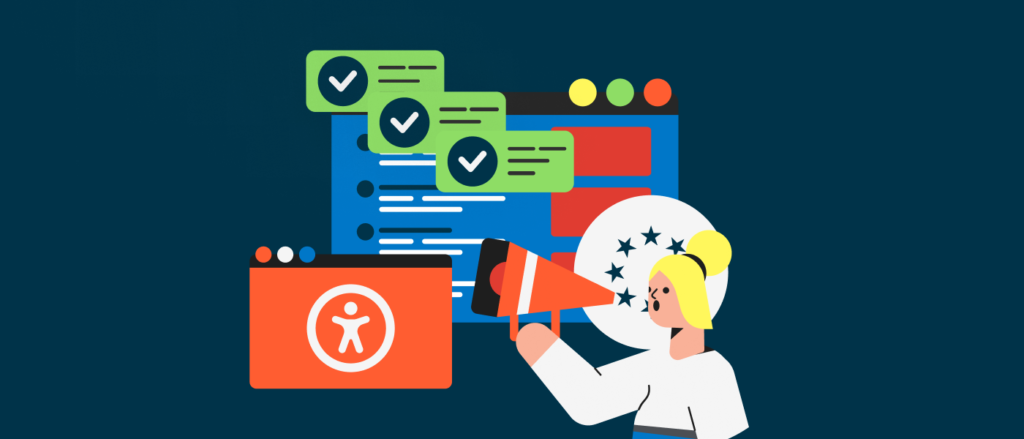For almost 25 years now, digital accessibility has been synonymous with the Web Content Accessibility Guidelines (WCAG). This standard, developed by the World Wide Web Consortium (W3C), set the bar for accessibility around the world. But, it’s not without its limitations. Most notably, WCAG is primarily written for web content. Its guidelines were not explicitly written for mobile apps, kiosks, GPS navigation devices, etc. And while people have tried to fit this WCAG-shaped peg into those various shaped holes, it is not always the best fit, and often more is needed. This is where EN 301 549 comes to the rescue.
What is EN 301 549?
EN 301 549 is a harmonized standard for the accessibility of Information Communication Technology (ICT) products and services. It is similar in scope to Section 508 standard. While written for the European market, it’s increasingly seeing adoption outside of Europe. EN 301 549 includes all requirements of WCAG 2.1 for web. This ensures that any web service that meets EN 301 549 also meets WCAG 2.1. But EN 301 549 has requirements that go far beyond web, including for:
- mobile and desktop apps
- non-web documents
- ICT with two-way voice communication
- ICT with video capabilities
- authoring tools (web or otherwise)
- electronic devices (ATMs, smart appliances, gaming consoles, etc.)
- and much more
EN 301 549 even has some requirements for websites that go beyond WCAG. Section 11.7 User Preferences, for example, requires that browser settings such as motion reduction and larger default fonts have to be respected by a website. Another example is that of authoring tools such as content management systems and video editing software. These need to enable and guide the creation of accessible content–something that the W3C kept out of WCAG. All together, EN 301 549 is a far more extensive set of requirements for ensuring minimal accessibility of all ICT products and services.
Who uses EN 301 549?
Following EN 301 549 has been required for EU governments by the Web Accessibility Directive (WAD) since 2019. With the European Accessibility Act (EAA) deadline set for June 2025, EN 301 549 will be the standard for any but the smallest organizations doing business anywhere within the 27 European Union member states. Even if you’re not based in Europe, if you have customers in the EU, you’re likely required to apply this standard in the development of your products and services.
EN 301 549 is also gaining significant traction outside of Europe. This standard has the Brussels effect working hard for it. In 2016, the Australian government adopted it for its ICT procurement policy, where it was republished as AS EN 301 549. Similarly, Canada has republished the standard as CAN/ASC – EN 301 549 and is exploring incorporating it into the Accessible Canada Act. The list doesn’t stop there. Japan, India, and Kenya have also published their own standards based on EN 301 549.
At this point, it’s more a question of who hasn’t started using EN 301 549 yet.
Using EN 301 549
Unlike WCAG, there are no understanding documents for EN 301 549. To try and address this, on April 10th the IAAP organized a workshop on the interpretation and testing of non-WCAG requirements of EN 301 549. I was one of the workshop facilitators during this event. This workshop is expected to start a larger project in which understanding and testing guides for EN 301 549 can be created. In the meantime, Deque has developed its own test methodology for EN 301 549 available on Deque University (subscription required). Deque also performs audits specifically for EN 301 549. Our axe ruleset and documentation also include information on how these rules relate to EN 301 549. There are currently no fully automated solutions for testing the non-WCAG parts of EN 301 549 because requirements have proven difficult to automate. But now that we live in the age of AI, who knows what might happen?
Conclusion
Over the last 9 years, EN 301 549 steadily gained importance. It is often dismissed as “WCAG with a different number slapped on it,” but it is far more than that. Disappointingly, the W3C has resisted calls to make its guidelines applicable to non-web content. This isn’t likely to change with WCAG 3.0 either. But Europe heard those calls and delivered an answer that’s being picked up everywhere from Canada to Japan. At Deque, we’ve been testing our products and services against EN 301 549 for some time now. With the European Accessibility Act (EAA) coming into force next year, many more organizations will need to do the same. If you’d like to know how your solutions measure up to EN 301 549, get in touch and request an audit.

